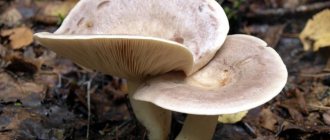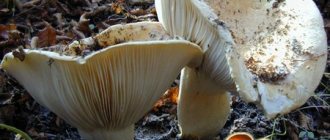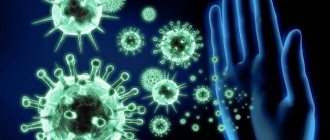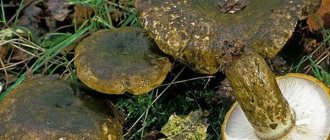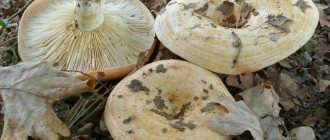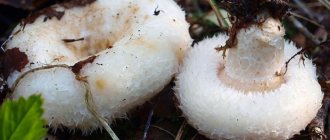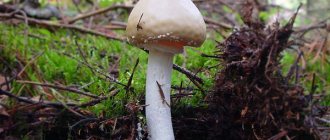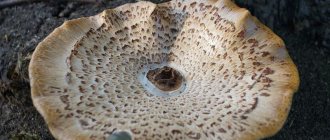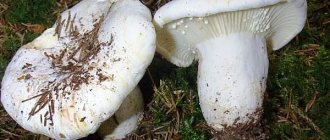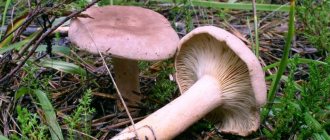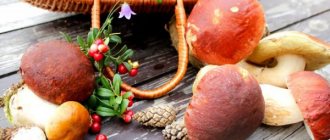What does milkweed mushroom look like?
The species is known by several names: red-brown milk mushroom, smooth milkweed, milkweed, milkweed, common milkweed, Lactarius volemus, best milkweed. The mushroom is dark brown or ocher in color. A white milky juice appears on the scrap or cut, which quickly darkens and thickens.
Description of the cap
At the beginning of the growing season, the cap is round, convex with folded edges. Over time, the shape becomes prostrate, the edges rise, and a slight concavity forms in the center.
The description of the milkweed mushroom cap shown in the photo is as follows:
- diameter – from 6 to 16 cm;
- the surface of young mushrooms is velvety, then dry, smooth, with a lack of moisture cracks appear;
- the coloring is often uniform; in adult milkweeds the central part may be darker;
- spore-bearing plates are cream-colored, sparsely located, descending onto the stalk, along the edge of the cap on the lower side there are shortened plates;
- spore powder is light beige or white;
- the pulp is thick, hard, light yellow.
The taste is sweetish, the mushroom can be eaten raw, the smell is nutty.
Description of the leg
The photo of the milkweed mushroom clearly shows that the stem is round, cylindrical in shape, tapering towards the base.
Its length is 10 cm. The color of the upper part does not differ from the color of the lamellar layer, the lower part is a shade darker. The structure is rigid, the surface is smooth, covered with fine, dense pubescence.
Similar species
Euphorbia is not similar to poisonous mushrooms.
Here are some of its “doubles”:
- Milky hygrophoroid.
It differs from milkweed in its sparse arrangement of plates. It is found very rarely, mainly near oak trees. Edible too.
- Milky is neutral.
This mushroom is browner with dark areas. Its juice, unlike milkweed juice, is yellow. Edible.
1- Hygrophoroid milky. 2- Milky is neutral.
- Milky gray-pink.
Has colorless juice. The smell is reminiscent of hay. It is conditionally edible precisely because of its specific smell.
- Real saffron milk cap (Mlechnik deliciosa).
It has a more orange color and a “hairy” stalk. Turns green when cut. Edible.
1- Milky gray-pink. 2- Ginger is real.
An experienced mushroom picker can easily distinguish the spurge mushroom from the rest. Moreover, it comes across quite rarely.
Is spurge mushroom edible or not?
The milkweed is edible, has a sweetish taste, and the milky juice is not bitter. Soaking of fruit bodies before processing is not required. Boil the spurge before frying to make the flesh of the leg softer. Used for pickling or pickling. After processing, mushrooms acquire elasticity and are characterized by a high gastronomic rating. In the West, dishes with milkweed are considered delicacies.
Salting red-brown milk mushrooms for the winter
The milk jug is ideal for harvesting for the winter. Lamellar milkweeds are considered the most delicious after salting. For processing, take young mushrooms that are not damaged by insects. It is better to leave old specimens for pickling, because during the pickling process the fruit body loses its elasticity and characteristic crunch.
Before salting, mushrooms are processed:
- The harvest is poured out and sorted by size.
- Remove the protective film from the surface of the cap and stem.
- The lamellar layer is cleaned of grass and debris.
- Wash several times.
- To get rid of insects, soak in water with vinegar and salt. Keep in the solution for 2-3 hours.
Attention! After soaking, debris is removed from the fruiting bodies and washed with hot water.
Hot salting method
To prepare mushrooms for the winter you will need:
- mushrooms – 5 kg;
- water – 5 l;
- bay leaf -10 pcs.;
- garlic – 2 heads;
- currant leaves – 15 pcs.;
- dill – 1 bunch (optional);
- salt – 10-12 tbsp. salt.
Cooking technology:
- To make the brine, boil water in an enamel pan, add salt and bay leaf.
- Sorted and washed mushrooms are placed in boiling brine for 30 minutes.
- The mushrooms are removed from the brine and washed with water.
- Pour salt into the pickling container and lay out the mushrooms in layers. Sprinkle with salt, dill, garlic.
- The top is covered with currant leaves.
- Close with a lid, which is pressed with a weight.
- After a few days, the mushrooms will release juice; they can be transferred to sterilized jars and closed for the winter.
The preparations are stored in the basement.
Where to collect milk mushrooms?
Milk mushrooms belong to the genus Mlechniki of the Russula family. There are no poisonous varieties among them, but there are slightly toxic ones that have an unpleasant taste and smell. If not properly cooked, their consumption may cause vomiting and diarrhea.
All types of milk mushrooms and milk mushrooms are classified as conditionally edible; they can be eaten only after soaking with frequent changes of water and subsequent salting. Only young mushrooms are collected. Old ones are difficult to process and cannot be used for food.
Mushrooms begin to grow after heavy rains. The average daily temperature should not be lower than 7-10º C. They come across large groups, and you can quickly collect a whole basket. Milk mushrooms are looked for under dry leaves of birch trees, rowan trees, under pine needles, ferns and in mosses.
Medicinal properties and contraindications of red-brown milk mushroom
The multicomponent chemical composition of milkweed has found application in folk medicine. The natural product is valued for its ability to:
- block bad cholesterol;
- improve the state of microflora in the intestines;
- act as an antioxidant;
Important! Milkweed has become a valuable source of protein and protein in dietary nutrition.
In cases of exacerbation of peptic ulcers or gastritis, or allergies, milkweed is consumed in limited quantities.
Black milk mushroom: photo and description
Black breast in the photo
Black breast, or nigella (Lactarius necator)
It has no resemblance to poisonous or inedible mushrooms.
Used for salting (after pre-soaking) and pickling.
When salted, it acquires a beautiful purple-cherry color.
The mushroom is edible. The cap is 5-15 cm, thick, fleshy, dense, slimy, sticky, initially convex with an uneven rolled edge, sticky in wet weather, then funnel-shaped, olive-brown, almost black in color, with faintly visible concentric zones, edges in young fruiting bodies caps are hairy, turned down. The plates are adherent, descending, often dirty yellowish with brown spots.
Look at the photo - this type of milk mushroom has legs that are olive, sticky, with depressed spots, short, 3-6 cm long, 2-3 cm thick:
Doubles and their differences
The milkweed has such a colorful appearance that it is difficult to confuse it with others. Euphorbia has no poisonous counterparts. The hygrophoroid milkweed is vaguely similar to the milkweed.
In the double, the color of the cap is uneven, with centric circles, and is rarely dry. The milky sap does not change color when it comes into contact with oxygen. The plates are spaced less frequently than on milkweed. The species are identical in nutritional value.
Medical use and beneficial properties
Euphorbia is widely used by traditional healers. It contains many useful substances, including:
- sugar alcohol;
- Volemitol;
- volemolide (mushroom ergosterol);
- cortisone;
- sterol;
- ethanol extract;
- vitamins D, PP, E? B9 B6 B2;
- alimentary fiber;
- ash.
Microelements include chromium, rubidium, cobalt, iron, fluorine and selenium. They are complemented by equally important potassium, phosphorus, magnesium, calcium and sodium. Euphorbia contains useful acids: tyrosine, valine, lysine, threonine.
The milky juice secreted by the fungus is actively used in alternative medicine and is used as a remedy against tumors and various inflammations. The mushroom also has other medicinal properties:
- strengthens the immune system;
- improves vascular function;
- preserves youth;
- accelerates the healing process of wounds;
- increases the amount of hemoglobin in the blood.
Moreover, the product retains all these qualities even after heat treatment. Euphorbia tincture is used to treat diseases such as:
- varicose veins;
- gout;
- haemorrhoids;
- rheumatism;
- otitis;
- bronchitis;
- flu;
- fever;
- gastritis;
- stomach ulcer.
It should be drunk 1 teaspoon twice a day. When you have a runny nose, it is recommended to lubricate each nostril with mushroom tincture. For gastrointestinal disorders, it is recommended to eat bread soaked in this medicine. To cure gastritis and stomach ulcers, you need to drink 1 teaspoon of juice three times a day.
In Japan, milkweed is widespread throughout the country. They even learned how to make rubber from it. However, this process is slowed down due to the seasonality of the fungus.
Why are mushrooms called that?
To answer this question, you need to know how and where they grow. These mushrooms “live” in large families; people call them piles or heaps. Many believe that it was for this feature that edible milk mushrooms were so named.
Even if you know well where these wonderful mushrooms grow, you need to learn how to look for them. They are perfectly camouflaged under a layer of foliage and fallen pine needles. Mushroom pickers go for mushrooms early in the morning - about five o'clock. You need to take a long stick with you, which you can use to probe all suspicious tubercles under birch trees, or near stumps. It is with these trees that these mushrooms prefer to grow in symbiosis, creating mycorrhiza.
There is another version why these mushrooms were named that way. The word “milk” comes from Hebrew and translated means “having a notch.” True, it is well known that the cap of this mushroom is funnel-shaped. Therefore, experts do not take this version seriously.
Literature
- Mushrooms: Directory / Transl. from Italian F. Dvin. - M.: “Astrel”, “AST”, 2001. - P. 124. - 304 p. — ISBN 5-17-009961-4.
- Grunert G.
Mushrooms / trans. with him. - M.: “Astrel”, “AST”, 2001. - P. 176. - (Guide to nature). — ISBN 5-17-006175-7. - Lesso T.
Mushrooms, key / trans. from English L. V. Garibova, S. N. Lekomtseva. - M.: “Astrel”, “AST”, 2003. - P. 54. - ISBN 5-17-020333-0. - Serzhanina G.I.
Hat mushrooms of Belarus. - Minsk: Science and Technology, 1984.
What types of milk mushrooms are edible?
In European countries, milk mushrooms are classified as inedible species. But, despite this, in Russia mushrooms are considered conditionally edible and suitable for consumption. But in order for the taste qualities of milk mushrooms to be fully revealed, it is necessary to carry out proper preliminary preparation. It consists of completely removing the caustic milky juice from the pulp. Otherwise, the mushrooms will have an unpleasant bitter taste and may cause an eating disorder.
Without exception, all conditionally edible types of milk mushrooms must be soaked in cold water for three days. In this case, you should constantly change the water to fresh water. After this, the mushrooms need to be boiled for another 20 minutes, and then the water should be drained. Only after such preparation can milk mushrooms be subjected to further processing.
Conditionally edible types of milk mushrooms:
- real (category 1) – suitable for salting and pickling;
- yellow (category 1) – used for salting and pickling, during processing the color changes to yellow-brown;
- aspen (3 categories) - mainly used for pickling, but also suitable for frying and preparing first courses;
- oak (3 categories) – used only for pickling;
- red (3 categories) – suitable for salting, marinating and frying;
- black (category 2) – used salted, when processed it changes color to purple-burgundy;
- watery zone (category 3) – used for salting and pickling;
- dry (3 categories) – this type is best fried, pickled and used for first courses;
- pepper (3 categories) – suitable for pickling, but changes its color to light brown, can be eaten only a month after pickling;
- bitter (3 categories) – suitable for salting and pickling;
- felt (3 categories) – can only be salted;
- parchment (2 categories) – suitable only for pickling;
- dog or blue (2 categories) - used only for pickling, since during pickling the shade becomes dirty blue.
Edible species:
- swamp (2 categories) – it is recommended to salt and marinate;
- camphor (3 categories) – can be boiled and pickled;
- bluish (3 categories) – used for pickling, requires a large amount of spices;
Important! No types of milk mushrooms can be used for drying.
Where do brown mushrooms grow?
Each mushroom species has its own requirements for soil composition, lighting, and humidity conditions. They also bear fruit at different times. Information about the places of growth and fruiting times of edible brown mushrooms is presented in the following table:
| Species name | Places of growth | Terrain features | Fruiting period | Geography of distribution |
| Porcini | coniferous, deciduous plantations, birch and oak groves, forests | mosses, lichens under coniferous and deciduous trees | June-September | cosmopolitan |
| Duboviki | deciduous and mixed forests | under oaks and lindens | June; Aug. Sept | everywhere |
| Motley flywheel | deciduous forest plantations | loose soils, mainly under beech trees | June-October | European part of Russia, Caucasus, Far East |
| Honey mushrooms | forests of any type | stumps, dead and weakened wood | June-January | everywhere |
| Chanterelle | forests of different types | moss, fallen leaves | June-October | everywhere |
| Boletus | aspen forests, deciduous and coniferous forests, birch groves | usually creates mycorrhizae with hardwoods | early summer – late autumn | Mainly in the European part and the Far East |
| Milkman | deciduous, coniferous and mixed forests | damp areas | August-October | everywhere, but rarely, singly or in small groups |
| Butter | coniferous plantations | under two- and five-coniferous pine and larch species | mainly in August | everywhere |
| Valuy | birch forests, mixed forests | damp shady places | mid-summer – October | European part, Western Siberia, Caucasus, Far East |
| Collibia oilseed | forests are predominantly coniferous | fallen needles | July-November | everywhere |
| Spruce fly | forests with spruce trees | forest floor, moss, heather | end of summer - first frosts | northern, central Russia |
| Edible raincoat | forests of predominantly deciduous type, gardens, parks | rotten wood | mid-summer – early autumn | wide distribution area, almost cosmopolitan |
| Greenfinch | coniferous forests | next to the gray rows | all autumn | everywhere |
| Lepiota corypus | deciduous and coniferous forests | fallen needles and leaves | autumn | rare view |
| Dark chestnut dog | coniferous and mixed types of forest plantations | dead wood, leaf litter | May-September | wide distribution area |
The period of fruiting of the mycelium largely depends on the weather and climatic conditions of the region as a whole. In different parts of the country, the same mushroom species may produce a harvest at different times.
Eating
Real milk mushrooms are usually salted after prolonged boiling. This removes the bitterness. Juicy and fleshy milk mushrooms, after they are poured with brine, acquire a slightly bluish tint. After forty days they are ready to eat.
Traditionally in Siberia, real milk mushrooms are pickled together with saffron milk caps and volnushki. They make pies with them, and offer guests cold milk mushrooms with horseradish and butter. In Western Europe, these mushrooms are considered inedible, but in Russia they have long been called the “kings of mushrooms.”
What are the benefits of milk mushrooms?
All edible and conditionally edible types of milk mushrooms are distinguished by a high content of easily digestible protein, surpassing even meat in quantity. They do not contain sugar, so people with diabetes can safely include these mushrooms in their diet. In addition, milk mushrooms help fight excess weight. They are low in calories, but at the same time satisfy hunger for a long time and provide the human body with useful vitamins and microelements.
These mushrooms also remove toxins, improve emotional health and digestion, and increase immunity.
How to deliciously cook milk mushrooms
A dish for every taste - fried milk mushrooms. Preparation begins with pre-soaking the mushrooms for two days with periodic changes of water. Cook the washed mushrooms for 5 minutes, drain the water and pour in new water, cook again for 5 minutes. Remove the mushrooms and wait to cool. Now the cap needs to be separated from the stem, they are hard in taste and will not be useful to us for frying. You can put them in the freezer for later use.
Fried milk mushrooms
The caps are cut into pieces and poured into a frying pan heated with oil. After 10 minutes of frying, the juice is poured out; it is not needed. Add greens, garlic and sunflower oil to the mushrooms, fry until golden brown and enjoy the taste.
